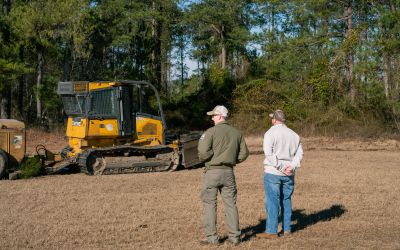Managing White Oaks During the Bourbon Boom
Bourbon’s popularity is on the rise around the United States. That means an equal rise in demand for white oak. Coopers use large, knot-free logs of this durable hardwood to make the barrels that give the spirit its rich flavors and amber hue. And those barrels can be used only once for the aging process. Combine those factors with the species’ slow growth rate, and it’s clear why white oak requires careful management for industry today and for future generations of toast makers.
“We’re starting to see the impact [the bourbon craze] is having on the white oak industry,” says Jeremy Scherf, a service forester with the Ohio Department of Natural Resources. “If we don’t step forward now and start improving how we manage our white oaks, we could be looking at a shortfall.”
The beautiful wood is also a favorite for high-end furniture. It doesn't rot as easily as some other species, so you’ll often find white oak used for trailer decks and other industrial applications.
Koral and Randy Clum, the 2018 National Outstanding Tree Farmers of the Year, are helping to meet the demand for white oak on their 150-acre Hepatica Falls Tree Farm in Dover, Ohio. The Clums’ forest management practices offer valuable examples for other tree farmers who want to promote white oaks on their property.
White oak is one of the most light-demanding trees, with a large canopy that can develop a spread of 50 to 80 feet wide. The Clums open up space around their oaks to let the canopies expand.
“In our past timber sales where we had young, pole-size white oak—say, four to 10 inches—we've opened those up by removing competing trees so we can develop those young oaks into future crop trees down the road,” Randy says.

The Clum Family, Ohio Tree Farmers.
Whenever Randy finds a young white oak along the farm’s trails or in newer-growth areas, he’ll make sure it has a chance to develop into a crop tree. “By using a little chainsaw therapy, putting a little time in, I can release those young white oaks so they’ll benefit not only us and our daughter but also someone down the road in the future,” he says.
The work doesn’t end there. “Once you open up the canopy, then yellow poplar and black cherry grow really quickly,” Koral explains. “They’re outcompeting the white oak.”
“We like to finesse our woods,” Randy says. “Clear-cutting is a valuable management tool to promote white oak. On our property, I’ll take the time to release individual trees. White oak is worth the effort. It's a valuable species for wildlife, the quality of the lumber, and in the cooperage industry to make barrels for high-quality spirits or wine. It's just a beautiful tree.”
Wildlife also benefits: Many animals prefer the tree’s sweeter acorn over that of the red oak, and several bird species feed on its leaf buds. “The deer love white oak,” Randy says. “By opening up the canopies to let them expand, there are more flowers. More flowers mean more acorns that the deer love. Our acorn crop has really increased to hold deer there.”
The Clums let their soil determine which type of trees grow in each area of Hepatica Falls. While they’re focused on white oak, they also make sure to figure out where every tree will grow best. Randy says he spends a lot of time looking at each tree, chainsaw in hand, thinking, “How can I help this tree grow better? How can I help it reach its potential so it grows fast and stays healthy?”
According to Scherf, it takes at least 80 years for a white oak to begin reaching a harvestable point. “That doesn’t mean it has hit its value point yet,” he adds. These trees can live up to 400 years, and many of the white oaks being harvested today are 150 to 200 years old. Patience is a must with this species.
“Anytime we’re managing trees, we have to think long term,” Scherf says.
“Sometimes, when the market’s good, like it is right now, people will tap white oak way before they’re ready,” Randy says. “By showing what can be done and cutting it at the right time, we can add a continuous, sustainable supply of this important product.”
The American Forest Foundation and partner organizations are working to help family tree farmers regenerate this important species through the White Oak Initiative, featured in the Fall 2018 issue of Woodland.
Related Articles

April 23, 2024
Turning Farm to Forest: Growing Loblolly Pine with Field to Forest
Wade Rabun has been working his land for years: he has most recently become the steward of a growing loblolly pine forest after enrolling in Field to Forest.

April 2, 2024
Georgia Landowner Grows Pines for Profit with Field to Forest
The Family Forest Carbon Program’s Field to Forest project is available to Georgia landowners who own 40+ acres of pasture or row crops.

February 20, 2024
For Conservation, Climate and Grapes
In Allegany County, you can spot newly planted grapevines. To the Trezise family, Kevin, Rene, and their son Bryce, this is the site of their future farm and vineyard.